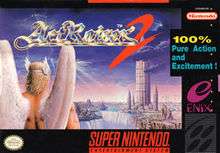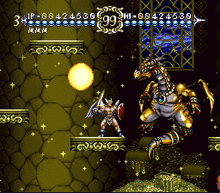ActRaiser 2
ActRaiser 2 (Japanese: アクトレイザー2 沈黙への聖戦, Hepburn: Akutoreizā 2: Chinmoku e no Seisen, lit. "ActRaiser 2: Crusade to Silence") is a side-scrolling platform game for the Super Nintendo Entertainment System developed by Quintet and published by Enix in 1993.
| ActRaiser 2 | |
|---|---|
 North American cover art | |
| Developer(s) | Quintet |
| Publisher(s) | |
| Director(s) | Masaya Hashimoto |
| Producer(s) | Tsuneo Morita |
| Artist(s) | Ayano Koshiro |
| Writer(s) | Tomoyoshi Miyazaki Ayano Koshiro |
| Composer(s) | Yuzo Koshiro |
| Series | ActRaiser |
| Platform(s) | Super NES |
| Release | |
| Genre(s) | Platform game |
| Mode(s) | Single-player |
The game is a sequel to the original ActRaiser, but the storyline is not directly connected to its predecessor; however, many plot details suggest that ActRaiser 2 may actually be set before the events of the original ActRaiser, or takes place in another universe entirely. Otherwise, the given story draws concepts from the famous religious epics Paradise Lost and the Divine Comedy.
Unlike the original game, which alternately combined platform game sequences and god game sequences, ActRaiser 2 is only a platform game.
Gameplay
Gameplay for ActRaiser 2 consists primarily of side-scrolling platform action, similar to the "Professional!"/"Action" mode from the original game, while completely removing the city building simulation.[1] The player, assuming the role of the "Master" (still referred to as "God" in the Japanese version), controls a floating palace to inspect the people of the world below. After hearing their plight, the Master descends to the world below to fight the monsters and rid the land of evil. Like the original, each area contains two "acts"; the first act of an area consists of monsters spawned from a lesser demon named after an unfavorable condition, while the second act consists of monsters spawned from the primary evil, named after one of the seven deadly sins, with heightened challenge and peril.
The side-scrolling action for ActRaiser 2 is more advanced than its predecessor. Controlling the Master, who now has a full set of functional wings, the player must navigate through dungeons and avoid certain perils by jumping, flying, falling, and floating to platforms. Armed only with a sword, and a shield which can deflect some attacks, the Master becomes heavily dependent upon magic. Magic is executed by holding down the designated button to "charge up" and is then released, consuming a magic scroll which is limited when the Master enters an area. When released, the magic may take various forms depending on the position of the Master. This is different from the first ActRaiser in which the player had to select a particular magic before descending down to the world to fight monsters and was limited to only that magic for the duration of battle. In ActRaiser 2, each magic is designed for particular situations and some magic is more powerful than others. By increasing the difficulty level at the options screen, the time it takes to "charge up" magic is increased, adding more difficulty to the game. The game's difficulty is also increased in that monsters require much more damage to be destroyed.
Plot
The game begins with the Master battling with Tanzra (still "Satan" in the Japanese version). In this game, a backstory is given as to why Tanzra hates the Master so vehemently. Tanzra, who was once the Master's servant, led a rebellion against him, but lost and was banished from Heaven.
Ripped and torn, the slain body of Tanzra fell to the underworld. Feeding on the intense hatred each held for the Master, Tanzra's seven deadly sins and their minions combined their power to raise the spirit of their mighty leader. Tanzra, now vowing revenge for his defeat by the Master, unleashed these demons upon the world. The player in this game assumes the role of the Master, aided by his angelic associates, known as Crystallis.
Some of the stages in the game are meant to be ironic regarding the blighting nature of Tanzra's demons. The townsmen in the city of Leon are sent to the underground prison of Gratis (meaning free without charge, or referring to "nadie entra gratis", no one enters for free) for not paying their taxes by a newly-appointed king named Kolunikus, who is afflicted by Greed.

After the player slays the first six deadly sins, the Tower of Babel (renamed "Tower of Sins" in the western versions), the final staged level of the game, appears, in which the Master fights the final sin, Pride, a mechanically engineered god. Defeating the false god, the player then descends into Death Heim, where he fights again against the seven sins, as well as Tanzra himself, a beast frozen waist-deep in a lake of ice (just as Satan was in the Inferno in The Divine Comedy).
During the game's ending, it is declared that "The Master will live forever" and, as the credits roll, an image of the statue of the Master is shown slowly eroding over time. The statue's sword and right wing fall off, suggesting the growth of civilization and the increase of mankind's self-sufficiency. This reflects the ending of the original ActRaiser, where the servant speculates that someday the world may be so independent that it will forget about the Master.
Development
According to developer Quintet, ActRaiser 2 was made at the request of Enix of America, and designed according to their specifications.[2]
Reception and legacy
| Reception | ||||||||||
|---|---|---|---|---|---|---|---|---|---|---|
| ||||||||||
The game sold about 180,000 copies worldwide, with 40,000 copies sold in Japan and Europe respectively and 100,000 sold in the US.[3] ActRaiser 2 was seen by some game writers as not as good as the original.[4]
Levi Buchanan of IGN wrote that while not as good as the original game, ActRaiser 2's allusions to Medieval religious texts and apocryphal storytelling is 'more than welcome'.[5]
In 1996 Sega announced that they would be publishing a Quintet-developed remake of ActRaiser 1 and 2, tentatively titled Act Remix, for the Sega Saturn.[6] However, roughly halfway through development Quintet concluded that the ActRaiser series was outmoded, and they drastically reworked the game, which was ultimately titled Solo Crisis.[2] Quintet started coding a third game in the ActRaiser series, for the Nintendo 64,[7] but never finished it. In May 2008, Fumiaki Shiraishi, the lead programmer for Final Fantasy Crystal Chronicles: My Life as a King, noted in an interview that he would like to make an ActRaiser sequel.[8]
References
- "Where's my sequel Actraiser?". Game Informer. Game Informer. Retrieved 13 August 2018.
- Kuboki, Kei; Loe, Casey (January 1997). "Japan Now Interviews". GameFan. Vol. 4 no. 1. p. 122. Retrieved 11 October 2018.
- "Quintet Game Library (Internet Archive)". Quintet. Archived from the original on 2005-03-06. Retrieved 2008-10-17.
- "The 25 best SNES games". Digital Trends. Digital Trends. Retrieved 13 August 2018.
- "ACTRAISER 2 REVIEW". IGN. IGN. Retrieved 13 August 2018.
- Loe, Casey (November 1996). "Actraiser Confirmed for Saturn". GameFan. Vol. 4 no. 11. p. 162. Retrieved 11 October 2018.
- Q, The (June 1997). "Gaming Gossip". Electronic Gaming Monthly. No. 95. Ziff Davis. p. 26.
- Parish, Jeremy; Sheffield, Brandon (May 12, 2008). "Content Kings: Square Enix's Shiraishi And Tsuchida On WiiWare And Risk". Gamasutra. Archived from the original on 9 November 2009. Retrieved 2009-12-08.